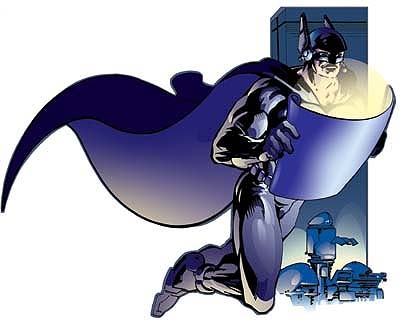S&V's Fantastic Four Page 6

by Al Griffin
With all the cool stuff hitting shelves this year, it's hard to imagine that the future holds even more cool stuff. But even as I write this, tech companies around the world are hard at work developing the next generation of video displays, storage formats, and Internet-based video-distribution systems. A few of these products - particularly the new flat-panel TV technologies - will be shaking up the TV biz in the very near future. And it's going to be fun watching the telephone companies take on the cable/satellite duopoly - offering up comparable programming and cooler features, presumably at lower cost. So here's a look at entertainment technologies that will join the fray in the next few years.
SED Canon has been working on SED (Surface-conduction Electron-emitter Display) since 1986, but a recent joint venture with Toshiba vaulted the technology into the big-screen spotlight. Like a plasma TV, an SED uses a flat glass panel lined with phosphor-coated cells. But whereas plasma relies on gas to illuminate the phosphors, SED uses a grid of emitters that propel electrons at the surface of individual cells - kind of like a cathode-ray tube without the tube. Having seen SED in action, I can verify that it combines CRT's deep blacks and subtle colors with plasma's crisp detail. Trial production of SED screens in the 50-inch range is underway in Japan. Expect to see SED go up against plasma and LCD in the U.S. in 2007 when mass production gets underway.
OLED Another flat-panel contender that flickered to life in the '80s and is expected to see mass production in big-screen TVs come 2007 is organic light-emitting diode, or OLED. Developed by Kodak, OLED creates images via carbon-based film layers positioned between sets of electrodes, one of which is transparent. Unlike LCD, where individual liquid-crystal cells modulate light from an external lamp, an OLED display directly generates electroluminescent light when voltage is applied to its emissive film layer. OLED's bright, high-contrast picture has made it a popular screen choice for cellphones, PDAs, and portable music players. Two familiar names expected to be key players in big-screen OLED are Samsung and Epson, both of which displayed prototype 40-inch OLED high-def sets at trade shows in 2005.
IPTV The same technology that lets us download and watch Family Guy clips on our computers will eventually transform TV entirely. Internet protocol TV (IPTV) is the next big thing that telcos like Verizon, Bell South, and AT&T are betting on to gain a foothold in your living room (see "The Connected House," January). Cable companies, meanwhile, are watching this closely and are likely to follow in the telcos' footsteps. Unlike traditional cable, where all channels are transmitted at once and then selected by a TV or an external cable box, IPTV systems, which require a broadband Internet connection, send only the channel you've requested. This "on demand" method brings a dramatic boost in bandwidth efficiency, letting the system offer an almost unlimited number of channels along with interactive features like personalized weather and stock-market data, and online games. And yes, HDTV will be part of the picture, too. Sounds a bit too pie in the sky? Consider this: the main supplier of IPTV software is none other than PC behemoth Microsoft. Also, Cisco systems, the leading supplier of Internet networking hardware, recently acquired Scientific-Atlanta, a leading maker of cable-TV boxes. If money actually talks, that move speaks volumes about the future marriage of the Internet and TV.
HVD With Blu-ray Disc and HD DVD slated to hit stores in the coming months, it's amusing to think that both formats could be bested by yet another disc format: Holographic Versatile Disc (HVD). The massive potential storage capacity of HVD - one terabyte (1,000 gigabytes) on a single disc - easily trumps the other two formats. That's enough to hold 80 hours of HDTV! The technology, which was invented by Japanese company Optware, uses two lasers: a green one that reads holographically encoded data on the disc's recording layer, and a red one that reads tracking information on a second layer. There aren't any products yet, but Optware has formed an "HVD alliance" with other Japanese companies to promote and standardize the technology, and backers include Toshiba. Optware predicts it will have low-cost HVD drives available as early as 2007.
- Log in or register to post comments





























































